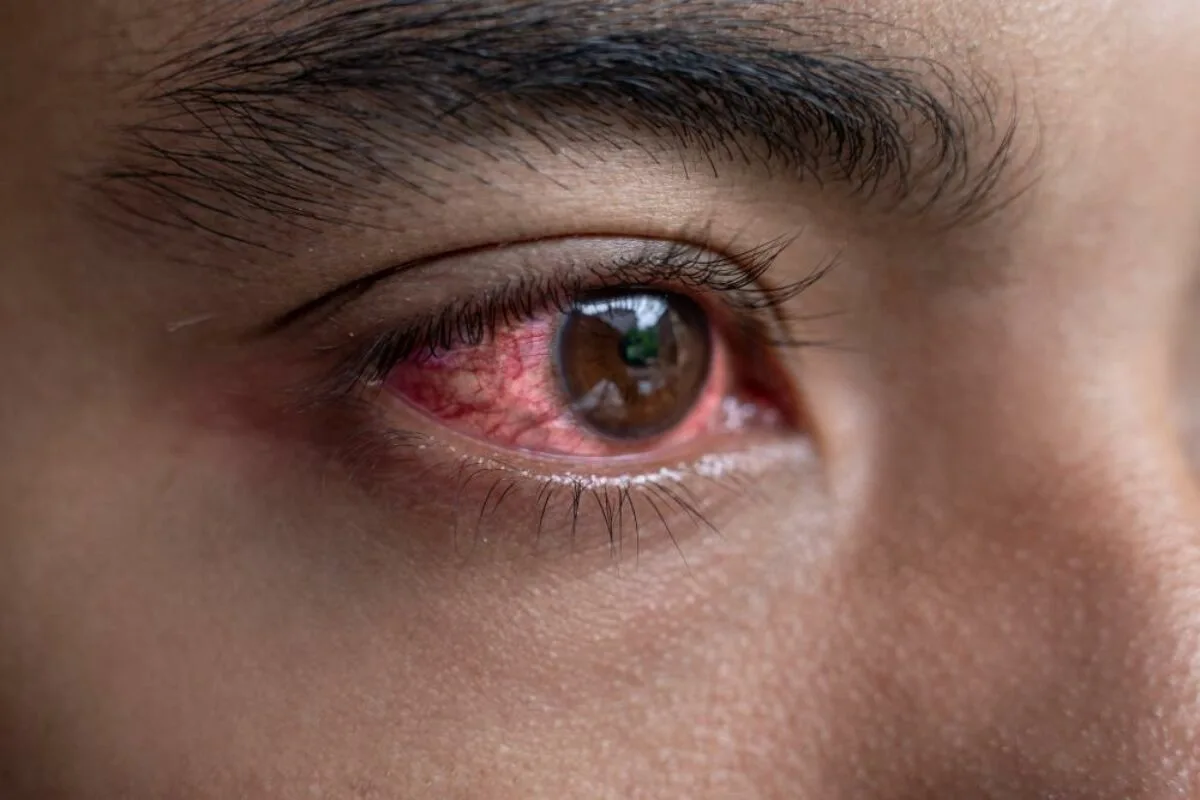Eye Flu Virus
What is an Eye Flu Virus?
Eye Flu Virus, medically known as conjunctivitis, is a common eye disease that affects people of all ages. It is characterized by inflammation of the conjunctiva, a thin transparent layer that covers the white part of the eyes and the inner surface of the eyelids.
Eye flu can be caused by a number of factors, such as viral or bacterial infections, allergies, or exposure to certain environmental irritants. This condition can be uncomfortable and embarrassing, but with proper treatment and care, most cases of eye flu will resolve without complications.
Types Of Eye Flu Virus
There are many types of flu in the eyes, each with different causes and characteristics:
Viral conjunctivitis
Viral conjunctivitis is the most common type of eye flu and is mainly caused by viruses such as adenoviruses, which also cause the common cold or flu. Eye flu is highly contagious and can easily spread through respiratory droplets or by touching surfaces contaminated with the virus. Viral conjunctivitis usually affects both eyes and can cause redness, irritation, watery discharge, and sensitivity to light.
Bacterial conjunctivitis
Bacterial conjunctivitis is caused by bacterial infections such as Staphylococcus aureus bacteria or Streptococcus pneumoniae bacteria. This can be caused by poor hand hygiene, sharing contaminated items, or touching the eyes with unwashed hands. Bacterial conjunctivitis can cause more serious symptoms than viral conjunctivitis, including a thick, yellow, or greenish discharge and peeling eyelids.
Allergic conjunctivitis
Allergic conjunctivitis is not caused by an infection but is caused by an allergic reaction to allergens such as pollen, pet dander, dust mites, or certain eye drops. This type of eye flu is not contagious and usually affects both eyes. Allergic conjunctivitis can cause itching, redness eyes, tearing, and swelling of the eyelids.
Chemical conjunctivitis
Chemical conjunctivitis occurs when the conjunctiva comes into contact with irritants or chemicals such as smoke, vapors, chlorine in swimming pools, or strong cleaning agents. This type of eye flu is not contagious but can cause redness, irritation, and discomfort in the eyes.
Causes Of Flu In Eyes
Eye flu, commonly known as conjunctivitis, is a disease characterized by inflammation of the conjunctiva, the thin transparent layer that covers the white part of the eye and the inner surface of the eyelids.
The causes of eye flu are various factors that cause discomfort, redness, and irritation in the eyes. Understanding the causes of eye flu is crucial to preventing its spread and ensuring timely treatment. In this article, we will examine the main causes of eye flu and the factors contributing to its development.
Viral infections
Viral conjunctivitis is one of the most common causes of eye flu. The primary eye flu cause of viral conjunctivitis is usually triggered by adenoviruses, which are the same viruses that cause the common cold and upper respiratory infections.
Viral conjunctivitis can be easily spread through respiratory droplets from an infected person or by touching surfaces contaminated with the virus and then touching the eyes. This type of eye flu is highly contagious and affects both eyes at the same time.
Bacterial infections
Bacterial conjunctivitis is another common cause of eye flu. This conjunctivitis is often caused by bacteria such as Staphylococcus aureus, Streptococcus pneumonia, and Haemophilus influenzae. A bacterial eye infection can occur when these bacteria enter the eye in a number of ways, such as through poor hand hygiene, sharing contaminated items such as tissues or eye makeup materials, or touching the eyes with dirty hands. Bacterial conjunctivitis can affect one or both eyes and cause more severe symptoms than viral conjunctivitis.
Allergy
Allergic conjunctivitis is a non-contagious form of eye flu caused by an allergic reaction to allergens such as pollen, pet dander, dust mites, mold spores, or certain eye drops. This is the main cause of eye flu in this type of allergy: When the conjunctiva comes into contact with an allergen, the immune system releases histamine, which causes the eyes to become inflamed, red, and itchy. Unlike viral and bacterial conjunctivitis, allergic conjunctivitis is not contagious and usually affects both eyes.
Environmental irritants
Certain environmental factors can trigger ocular flu-like symptoms due to conjunctival irritation. Exposure to smoke, air pollution, pool chlorine, and harsh chemicals can cause temporary conjunctivitis and discomfort. These irritants can cause red, itchy, and watery eyes, but they are not contagious or spread from person to person.
Contact lens wear
Contact lens wearers can also be susceptible to eye flu, especially if they do not follow proper hygiene practices. Contaminated contact lenses or lens cases can introduce harmful bacteria or viruses into the eyes, causing conjunctivitis. Contact lens wearers need to follow strict hygiene practices, including proper cleaning, disinfection, and regular replacement of lenses, to reduce the risk of eye infections.
Neonatal conjunctivitis
The main cause of eye flu Neonatal conjunctivitis is often caused by an infection acquired during childbirth. This condition, called neonatal conjunctivitis or ophthalmia neonatorum, requires prompt medical attention to prevent complications and protect the baby and vision.
Symptoms Of Eye Flu Virus
Eye flu can have a variety of symptoms that can vary depending on the cause.
Redness and irritation
One of the main symptoms of eye flu is redness and irritation of the eyes. The conjunctiva becomes inflamed, causing the blood vessels in the eyes to dilate, causing the eyes to turn pink or red. The eyes may scratch, itch, or feel as if there is something foreign in them. This redness and irritation are often noticeable in the morning or after periods of rest.
Watery eyes
Excessive tearing, which causes watery or watery eyes, is another common symptom of cold in the eyes. The main cause of eye flu due to watery eyes is inflammation of the conjunctiva, which can stimulate the lacrimal glands and cause tears to overflow. Watery eyes can cause discomfort and blurred vision, making everyday tasks difficult.
Photosensitivity
People with eye flu can develop photosensitivity, a condition in which the eyes are sensitive to light. Exposure to bright light or sunlight can cause eye discomfort and pain, causing people to squint or shield their eyes from light sources.
Discharge from the eyes
Thick, sticky discharge from the eyes, especially after waking up, is a typical symptom of bacterial conjunctivitis. This discharge is often yellow or greenish in color and can cause eyelids to stick together. Conjunctivitis caused by a virus can also cause a watery or clear discharge from the eyes.
Grainy feeling
Some people with the flu may have a gritty or gritty feeling in their eyes as if there is garbage. This rough feeling is often associated with conjunctivitis and can be embarrassing.
Eyelid crust
In bacterial conjunctivitis, discharge may dry and harden overnight, causing a crust around the eyelids. When people wake up, these shells can make it difficult to open their eyes.
Swelling of the eyelids
Swelling of the eyelids is a possible symptom of eye flu, especially if it is caused by an allergy. Allergic conjunctivitis can cause swelling of the eyelids, making the eyes swollen and puffy.
Discomfort when blinking
People with eye flu may experience discomfort or pain when blinking due to inflammation of the conjunctiva. Blinking can aggravate the irritation and cause more discomfort.
Contagiousness of eye discharge
Contagiousness of flu in the eyes depends on its underlying cause factor. Viral and bacterial conjunctivitis is highly contagious and can spread from person to person through direct contact or respiratory droplets. On the other hand, allergic conjunctivitis is not contagious and does not spread from person to person.
Risk Factors of Eye Flu Virus:
- Exposure to someone infected with viral or bacterial conjunctivitis
- Exposure to the most allergenic substance.
- Wearing unhygienic contact lenses or poorly fitting contact lenses
- Not washing hands and touching eyes frequently
- Using infected tissues and wipes
- Using infected eye makeup.
Diagnosis Of Eye Flu Virus:
Diagnosing eye flu (also known as conjunctivitis) involves a thorough eye exam and a thorough evaluation of the patient and their symptoms and medical history. Because eye flu can be caused by a number of factors, including viral or bacterial infections, allergies, or exposure to environmental irritants, identifying the underlying cause is critical for effective treatment.
Eye exam:
The first step in diagnosing eye flu is a detailed eye exam by an eye doctor, such as an optician or ophthalmologist. During the examination, the doctor:
- Checks visual acuity: Evaluate the patient and visual acuity to determine if there are changes in vision.
- Check the conjunctiva: Check the conjunctiva for inflammation, redness, or swelling.
- Observe the eyelids: Check the eyelids for crusting, swelling, or discharge.
- Assess the cornea: Check for corneal abnormalities or signs of infection.
- Measuring student feedback: Assessing students and #039; react to light to ensure they are working properly.
The eye doctor also takes a detailed medical history, which includes information about:
- Symptoms: The patient is asked about his symptoms, including eye discomfort, onset, duration, and severity of redness. , itching or discharge.
- Recent illnesses: Information about recent illnesses or exposure to infected individuals may be important in identifying viral or bacterial causes.
- Allergy: Allergy to certain substances, such as pollen or pet dander, is considered to assess the possibility of allergic conjunctivitis.
- Use of contact lenses: If the patient wears contact lenses, the eye care specialist will ask about the hygiene and frequency of use of the lenses.
Further Investigations:
Depending on the examination, history, and care, finding. findings, a specialist can confirm the diagnosis and certain types do further tests to identify conjunctivitis:
- Eye swab: if bacterial conjunctivitis is suspected, a cotton swab can be taken from the eye secretion of the causative bacteria and the most appropriate antibiotic. treatment can be chosen. can be determined.
- Allergy test: If allergic conjunctivitis is suspected, an allergy test may be performed to identify the specific allergens that trigger the reaction.
- Fluorescein stain: In this test, a special dye called fluorescein is applied to the eye and its surface to detect corneal abrasions or other injuries that may cause ocular flu-like symptoms.
- Tear Film Evaluation: Tear film tests can be performed to evaluate tear film production and tear film stability, which can help diagnose conjunctivitis associated with dry eye.
Medical Treatment
Your eye doctor can prescribe medicines to relieve its symptoms and speed up recovery. Such remedies may include:
Eye flu medications
- Antihistamines: Over-the-counter antihistamines can provide temporary relief by reducing itching and allergic reactions associated with this eye infection.
- Nonsteroidal anti-inflammatory drugs (NSAIDs) can also help reduce inflammation, redness, and discomfort in the eye itself.
- Pain relievers: OTC pain relievers such as acetaminophen or ibuprofen can help relieve headaches or general discomfort such as eye pain..=
Eye Flu Treatment
Treatment for the eye flu virus depends on the cause and severity of the eye condition. Here are some treatment options:
Redness and irritation
One of the main symptoms of eye flu is redness and irritation of the eyes. The conjunctiva becomes inflamed, causing the blood vessels in the eyes to dilate, causing the eyes to turn pink or red. The eyes may feel scratchy, itchy, or as if there is something foreign in them. This redness and irritation are often noticeable in the morning or after periods of rest.
Watery Eyes
Excessive tearing that causes watery or watery eyes is another common symptom of eye flu. Conjunctivitis can stimulate the lacrimal glands and cause tears to overflow. Watery eyes can cause discomfort and blurred vision, making everyday tasks difficult.
Photosensitivity
People with eye flu may have photosensitivity, a condition in which the eyes are sensitive to light. Exposure to bright light or sunlight can cause eye discomfort and pain, causing people to squint or shield their eyes from light sources.
Discharge from the eyes
Thick, sticky discharge from the eyes, especially after waking up, is a typical symptom of bacterial conjunctivitis. This discharge is often yellow or greenish in color and can cause eyelids to stick together. Viral conjunctivitis can also cause a watery or clear discharge from the eyes.
Gritty Sensation
Some people with eye flu may have debris or debris in their eyes as if it were garbage. This rough feeling is often associated with conjunctivitis and can be embarrassing.
Peeling of the eyelids
In bacterial conjunctivitis, the discharge can dry and harden overnight as a crust forms around the eyelids. When people wake up, these shells can make it difficult to open their eyes.
Swelling of the eyelids
Swelling of the eyelids is a possible symptom of eye flu, especially if it is caused by an allergy. Allergic conjunctivitis can cause swelling of the eyelids, making the eyes swollen and puffy.
Discomfort when blinking
People with eye flu may experience discomfort or pain when blinking due to inflammation of the conjunctiva. Blinking can aggravate the irritation and cause more discomfort.
Contagiousness of eye discharge
The contagiousness of eye flu depends on its underlying eye flu cause. Viral and bacterial conjunctivitis is highly contagious and can spread from person to person through direct contact or respiratory droplets. On the other hand, allergic conjunctivitis is not contagious and does not spread from person to person.
How long does eye flu last?
The duration of eye flu depends on the type of conjunctivitis and its underlying cause:
- Viral conjunctivitis: Viral conjunctivitis is the most common type of eye flu and is mainly caused by viruses such as adenoviruses. It is highly contagious and is easily spread through respiratory droplets or by touching surfaces contaminated with the virus. The duration of viral conjunctivitis can vary from a few days to two weeks. In most cases, symptoms gradually improve over time without specific treatment. However, proper treatment, such as using warm compresses and lubricating eye drops, can help ease discomfort during the healing process.
- Bacterial conjunctivitis: Bacterial conjunctivitis is caused by bacterial infections such as Staphylococcus aureus bacteria or Streptococcus pneumonia bacteria. It can cause more serious symptoms than viral conjunctivitis, including a thick, yellow, or greenish discharge and peeling eyelids. With appropriate antibiotic therapy, bacterial conjunctivitis usually resolves within a few days. A fully prescribed course of antibiotics is necessary to completely eradicate the infection and prevent recurrence.
- Allergic conjunctivitis: Allergic conjunctivitis is not caused by an infection, but is caused by an allergic reaction to allergens such as pollen, pet dander, or dust mites. The duration of allergic conjunctivitis can vary depending on the person the exposure to allergens and the effectiveness of allergy treatment. Avoiding allergens and using antihistamine eye drops or oral medications can help relieve eye flu symptoms and shorten the duration of the condition.
- Chemical conjunctivitis: Chemical conjunctivitis occurs when the conjunctiva comes into contact with irritants or chemical material. The duration of chemical conjunctivitis depends on the severity of irritation and the type of irritant. Flushing the eyes with clean water and avoiding further exposure to the irritant may aid healing.
- The general health and immune response of an infected person can also affect the duration of eye flu. People with strong immune systems can recover faster than people with weakened immune systems or those with underlying medical conditions.
Preventive And Hygienic Practices
Protect yourself and others from this eye problem by following the following hygiene practices to minimize the risk of infection:
- Wash your hands regularly with soap and water for at least 20 seconds before touching your face. . facial features or eyes, including touching or rubbing them. Direct contact with eyes can cause viruses and bacteria.
- Use tissues or your elbow: When you cough or sneeze, a tissue or cough into your elbow helps prevent the further spread of respiratory droplets.
- Avoid sharing personal items: Never share towels, cosmetics, or other personal items that could come into contact with anyone.
- Cleaning and Disinfection of Surfaces: Remember to disinfect regularly touched surfaces such as doorknobs, work surfaces, and electronic equipment.
- Practice good contact lens hygiene: If you wear contact lenses, be sure to follow proper hygiene practices, such as disinfecting and changing them on a schedule.
Home Remedies For Eye Flu
- Cold Pack: To reduce swelling and stop itching, apply an ice pack or cold pack to closed eyes for a few minutes.
- Warm compress: Sometimes a warm compress treatment can also help. Take a clean cloth soak it in warm water and squeeze it; Then apply it on your closed eyes for a few minutes to improve your eyes.
- Saline: Washing your eyes with a homemade saline solution made by mixing salt with distilled water can help clear your eyes and relieve irritation.
- Tea Bags: Chilled chamomile or green tea bags should be placed on closed eyelids to relieve redness and inflammation.
- Adequate rest and sleep will allow your body to recover and strengthen your immune system to fight this eye infection.
FAQ
Can this infection be prevented?
It can be prevented by following good hygiene practices such as regular hand washing, avoiding direct contact with eyes, and regularly disinfecting surfaces. In addition, it is wise to limit close contact with people who have an active eye infection.
How long does this infection usually last?
Viral conjunctivitis usually lasts one to two weeks. However, the exact duration may depend on its severity and individual circumstances.
Should I wear makeup if I have this eye infection?
In general, it is wise to avoid eye cosmetics during this flu outbreak, as their use can worsen symptoms and increase the risk of reinfection.
Does it cause permanent vision loss?
This infection does not usually result in long-term vision loss; however, severe or untreated cases can lead to complications that negatively affect vision.
Are antiviral drugs always necessary?
In most cases, its symptoms resolve on their own over time without antiviral eye drops; However, for serious infections caused by some viruses, they can prescribe drops prescribed by your doctor.
How do you get rid of eye flu?
You just need to rest your eyes, use a hot or cold compress, and follow your doctor’s instructions. Over-the-counter lubricating drops can help relieve discomfort.
Reference
Masoodi, T. (2023, October 4). What is Eye Flu or Conjectrivtis: Causes, Symptoms, Treatment – Best eye specialist Hospital near you in. DrKashishGupta. https://drkashishgupta.com/what-is-eye-flu-or-conjectrivtis-causes-symptoms-treatment/
Eye Flu: Causes, Symptoms, and Effective Treatment. (n.d.). Felix Hospital. https://www.felixhospital.com/blogs/eye-flu-causes-symptoms-and-effective-treatment
Saxena, K. (2023, November 29). Eye Flu: Symptoms, Reasons and Treatments. MyHealth. https://redcliffelabs.com/myhealth/health/eye-flu-reasons-symptoms-and-treatments/
Eye Flu or Conjunctivitis: Causes & Prevention Strategies. (n.d.). Save Sight Centre. https://www.savesightcentre.com/eye-flu.php






